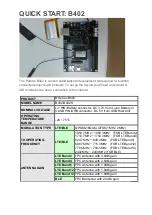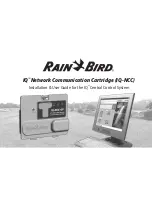
Remote Programming
103
CTC100 Programmable Temperature Controller
Some resistive cryogenic temperature sensors such as Rhodium-Iron, Germanium, and Carbon-
Glass are not included in the list of available sensor types because they do not have standard
calibration curves. To use these sensors, set the Sensor type to Thermistor or ROX and load a
Changing the sensor type may affect how the CTC hardware acquires data from the sensor. In
particular, if the sensor type is changed from
Thermistor
to
Diode
, the CTC acquires voltage
instead of resistance readings and a special high-accuracy excitation current source is used. Also,
the
RTD
setting results in larger excitation currents than the other settings.
The sensor type also affects which instructions are available in the
channel.
Cal
menu. For
example, if the sensor type is
RTD
, the
channel.
cal.type
instruction offers a list of RTD types,
-van Duzen coefficients appear in the
channel.
cal
submenu.
Channel.
Stats { on, off }
Using the remote interface, the average and standard deviation of the most recent n ADC
readings can be continuously calculated, where n is defined using the
channel
.Points
instruction. The values can be displayed on the graph screen using the
System.Display.Stats
instruction or queried with the
channel
.Average
and
channel
.SD
instructions.
Channel
.Stats
turns sliding-window statistics collection on or off for a channel. When
statistics collection is turned on, the average and standard deviation over the most recent n ADC
readings are calculated at each ADC conversion and can be displayed on the single or multiple plot
screens or queried via the Average and SD instructions. n is the smaller of 1) the number of ADC
readings acquired since statistics collection was enabled; 2) the number defined with the
channel
.Points
instruction; or 3) the number of ADC readings acquired since the Points
instruction was last issued.
This command is only available through the remote interface.
Channel.
Units { W, A, V }
(Heater output channels only)
By default, the outputs of the heater driver cards are measured in watts. Using the
Units
(heater voltage). Note that the
low lmt
and
hi lmt
settings are not automatically converted to
the new units.
Channel.
Value
0.0
If the indicated channel is an output,
channel
.value
changes
Regardless of whether the channel is an input or an output,
channel
.value?
returns the current
value of the channel. Attempting to set its value of an input channel produces a run-time error.
Attempting to set the value of an output channel when outputs are disabled also produces a run-
time error. Setting the value of an output channel under feedback control has no effect, but no
error is generated.
Examples:
Out1.value = 1.0
Sets channel Out 1 to output 1 watt of power. Note that
e
omitted.
In1.value?
Queries the output of channel In1. The response is a numeric value such as
37.4722
if
System.Com.Verbose
is set to Low or Medium, or
Содержание CTC100
Страница 1: ...Version 2 1 May 14 2019 User Manual CTC100 Cryogenic Temperature Controller...
Страница 6: ......
Страница 8: ......
Страница 12: ......
Страница 25: ...Operation 13 CTC100 Programmable Temperature Controller...
Страница 85: ...Operation 73 CTC100 Programmable Temperature Controller To disable cascade cont select it...
Страница 128: ......
Страница 129: ...Remote Programming 117 CTC100 Programmable Temperature Controller...
Страница 130: ......
Страница 142: ......
Страница 150: ......
Страница 176: ......
















































